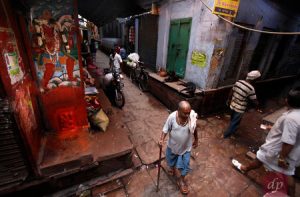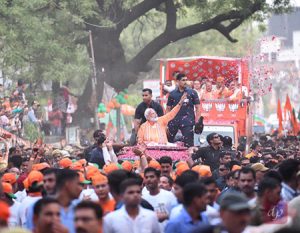Varanasi: The Prime Minister’s Constituency
Varanasi, the temple city got the prominence as prime minister’s constituency, and ghats are cleaner than before and various developmental activities are streamlined under smart city programmes to make the city a clean and green city. However, regular and more realistic reviews are to be done to make a unique heritage city.

Varanasi assumed a major significance in the political map of India when Narendra Modi decided to contest from Varanasi in 2014 Lok Sabha election. For the second term as well, in 2019 Lok Sabha election PM Modi defeated his opponents with huge margin of votes. Varanasi traditionally known as Banaras in India is a popular holy city located in the central region of Ganges Valley in North India. This city is not just the oldest city in India but also happens to be the oldest colonized cities universally. It is now the Prime Minister’s Constituency. Narendra Modi has launched several developmental projects in Varanasi in order to bring about the essential changes at the same time keeping its heritage and tradition intact. Many of these projects have been allotted heavy budget in order to fulfil the vision for Varanasi.
Varanasi post Modi
The old power cable system has been dismantled after a project to lay underground lines was done. The larger part of the city has experienced the change whereas the work is under progress in some parts of the city. Varanasi has a very busy airport naturally because of the movement of pilgrims and tourists. It is amongst the most visited place by tourists in country. Ring Road will ease traffic congestion in the city and facilitate travel to nearby towns and Babatpur Airport highway has been developed under Modi’s tenure in order to ensure an easy travel from and to the airport and goes onto link Jaunpur, Sultanpur, and Lucknow.
India had never tapped its inland waterways before and left the resource unutilized. This changed when the Prime Minister launched Jal Marg Vikas Project of Inland Waterways Authority of India. India’s first multi-modal project was inaugurated by the Prime Minister in his constituency and received the country’s first cargo transported on inland waterways to Varanasi from Kolkata. PM Modi launched projects for making the cancer hospitals in Varanasi, which were inaugurated recently by him– Madan Mohan Malviya Cancer Centre of Banaras Hindu University and Homi Bhabha Cancer Hospital, Leharatara, jointly setup by the trusts – Banaras Hindu University and Tata Memorial Centre. The hospitals are likely to provide affordable cancer care to patients. He will also dedicate the first new Bhabhatron, an indigenous tele cobalt machine for cancer treatment, to the nation.
Also Read : Explaining the Modi wave in the 2019 Lok Sabha Elections
The Lal Bahadur Shastri International Airport in Varanasi now has increased number of flights by four or five times and new flight destinations such as Bhubaneshwar, Chennai, Guwahati and more have been set about.The makeover of the Manduadih Railway Station in Varanasi under the redevelopment project of railway station gives it an airport like look by installation of LED lights, air-conditioned lounges, walls adorned with traditional folk art, fountains to beautify the railway station and make it passenger friendly.
The superfast Vande Bharat which covers the distance of 775 km from Varanasi to New Delhi in eight hours has been set as a target for railways which was launched in February 2019.
Being the producer of the world famous Banarasi silk sarees and brocades, it is also known for hand-knotted carpets, sculptures and several other handicrafts. The government has set up Deen Dayal Hastakul Centre, a trade facility and a museum of handicrafts, which offers space to award winning weavers and craftsmen to sell their products, promoting thus the handicrafts at domestic and international level. This is also a site of attraction for the tourists, at the same time preserving and protecting the handicrafts and the weavers.
How is PM Modi transforming his constituency into a Smart City?

The Prime Minister’s constituency has been selected to be developed under the smart cities project. The Smart City developmental project has been set upon the following principles: Suramya Kashi (picturesque), Samunnat Kashi (progressive), Surakshit Kashi (secure), Sanyojit Kashi (organized), Nirmal Kashi (pure), and Ekikrit Kashi (unified). With a flourishing tourism industry and maintaining the heritage of the city the PM can make it a unique smart city. The total estimated cost of the Varanasi smart city will be used to spend upon the rejuvenation of ghats, infrastructure and e-governance. A local says that the electricity conditions have improved in the city; earlier in summers the electricity was provided for seven to eight hours in a day whereas now, there is almost no power cut.
Varanasi is known for its ghats and therefore the government has worked upon the redevelopment of Ghats from Panchganga Ghat to Assi Ghat by installing LED lights, maintenance of infrastructure, and by cleaning of the banks of the river. In addition, there would also be a night bazaar at Assi Ghat to promote the handicrafts and local cuisines of the city.The city has also proposed electric crematoriums along the ghats which are cost efficient, environment friendly and less time consuming.There has been a provision to make ramps for people with disability at the railway stations and pedestrian friendly streets.
The government has also made provisions of a single access card for the integrated online payments for several means of transport. There would be upgrades made in the utilities and entry fees to the heritage sites in the city. In addition to this, there is also a provision of Varanasi metro under the Smart Kashi project. Under the plan all the popular historic sites will receive a digital signage along with interactive panels and maps. It will also involve traffic sensors, public bicycle sharing system and smart LED lights to brighten the overall city.
Under the Namami Gange Programme launched by the Union Government, integrated efforts are envisaged to clean, protect and rejuvenate the Ganga River by combining the existing ongoing efforts and formulating action plans to provide a concrete plan in future to protect the river. The government under the scheme has involved people living on the banks of the river. A large number of Gram Panchayats on the banks of Ganges will be made defecation free by 2022 which will be possible by involving the State Programme Management Groups and the Panchayati Raj institutions. There will be a thorough checking of the pollution level in Ganga. The council responsible will ensure treatment of waste water in drains by applying bio-remediation method and by in-situ treatment. It will be done by usage of innovative technologies through municipal sewage and effluent treatment plants. The government has also distributed e-boats and a large number of dustbins have been installed at the ghats.
Loopholes in the developmental policy
Although the government has been working intensively to improve the conditions in Varanasi and turning it into a smart city, there have been many challenges faced by them. Even after the compensation granted by the government for acquisition of land, there are many who resist moving out, as stated by a local, Nikhil Jaiswal:
The essence and beauty of Varanasi lies in its alleys (galis) and people living here oppose living outside the territory of Kashi, as they believe that Moksha will be attained by living within the domestic territory of the holy city.
Hence, a lot of opposition was felt when the alleys near Kashi Viswanath Temple were demolished. Due to reallocation, many locals have lost their jobs or have to travel a larger distance for their work. Though Varanasi comes under the smart city project the Prime Minister has not spoken about business development and has not held a meeting with the local industrialists and businessmen to discuss the problems in order to reduce unemployment. There have not been any provisions to lay foundation of a factory. Another businessman, Ashok Kumar Gupta states that,“after implementation of GST, many businesses have been continuously facing a loss, manufacturing and sales have also fallen, the fundamental way of business had to be changed, as a receipt book system is to be maintained. It is not possible for every small scale business to maintain a receipt book as they have not been educated enough about the maintenance of the accounts but excel in their skill.”
Also Read : National Waterways The lifeline Of India
The roads are dug in different areas of Varanasi for a long period of time which leads to traffic congestion. Sewage disposal still remains a problem in the city even after the installation of sewage treatment plants. A local, Shruti Gupta, says that “there is no visible improvement in the quality of the Ganges water as it was expected by us, also a lot of tress has been cut down for the infrastructural developmental projects which have led to increase in the temperature of the city.” Hence, Namami Gange has not been as successful as it was expected to by the people after the heavy budget allotment. Even after setting up of a handicrafts museum the promotion of the handicrafts has not been done adequately, due to which many weavers are unable to earn profits. In spite of installation of electric crematoriums, out of the two one is still dysfunctional whereas Harischandra Ghat and Manikarnika Ghat witness more than hundred dead bodies on a daily basis. The people prefer to use the traditional way to perform the last cremation rites and consider electric cremation as a taboo.
Development in a city like Varanasi may seem a challenge but the government has been able to bring about a lot of changes in the city and many projects are still underway which are expected to be completed soon to fulfil the vision for this holy city.
